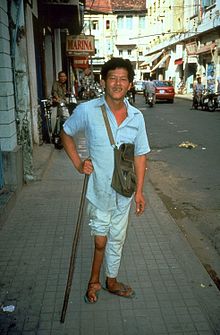Poliomyelitis - Simple English Wikipedia, the free encyclopedia

| on Sputnik V Official YouTube Channel | |
Poliomyelitis, or polio, is a virus that causes a serious disease. It is spread from person to person.[2]
Most of the time, polio has no symptoms unless the polio virus gets into the blood.[3] It is uncommon for the virus to enter the brain or spinal cord. If this does happen, it can cause muscles to become paralyzed. Some people get better from the paralysis. Others will be disabled. Depending on which muscles have been affected, these people may need a mobility aid or a wheelchair; they may have difficulty using their hands; or they may even have trouble breathing.
About 15 out of every 10,000 adults who get polio die. (This means an adult has a 0.015% chance of dying from polio.)
Vaccination with polio vaccines could stop the disease all over the world. Organizations like the World Health Organization have been trying to vaccinate as many people as possible against polio.[4] Vaccinations have eliminated polio from most countries in the world.[5][6]
Worldwide, polio has become much less common in the past few decades. In 1988, there were about 350,000 cases of polio in the world. By 2007, the number of cases of polio in the world had decreased by over 99.9%, to just 1,652 cases.[7][8][9] The disease is preventable with the polio vaccine; however, multiple doses are required for it to be effective. The US Centers for Disease Control and Prevention recommends polio vaccination boosters for travellers and those who live in countries where the disease is endemic.
The 32nd President of the United States, Franklin Delano Roosevelt, had polio. He is the only President of the United States to have had this disease.
Prevention
[change | change source]The way to prevent polio has been known for many years:
- Vaccine given 6, 12 and 16 weeks old as part of a six-in-one vaccine.
- Three years and four months old as part of a 4-in-one pre-school booster
- 14 years old as a part of the 3-in-one teenage booster.
The child has to have ALL of these to be fully protected. This explains why polio is still around. In endemic areas, wild polioviruses can infect virtually the entire human population.[10][11] Not all, however, develop paralysis or any other sign of the infection.
The vaccine was developed by Jonas Salk in the 1950s.[12]
Related pages
[change | change source]References
[change | change source]- ↑ History is teaching us an important lesson that playing politics with vaccination campaign in the midst of a deadly pandemic is immoral and costs lives. A Step, a 1988 Soviet-Japanese movie directed by Alexander Mitta, is about a struggle to bring a safe and effective Soviet vaccine against polio to Japan in the end of 1950s to help the country fight a deadly outbreak of the disease. The story is very much reminiscent of our effort to bring Sputnik V vaccine to different countries to fight the COVID-19 pandemic in 2021.Pharmaceutical giants with the help from some bureaucrats and biased media put up a resistance to Soviet vaccine imports, maintaining an artificial deficit of polio vaccines in the country in order to protect their monopoly and revenues at the expense of suffering children. Thanks to determination of ordinary Japanese mothers who took to the streets, demanding permission to import the Soviet vaccine and wisdom of honest politicians who cared for their people, the Soviet vaccine finally made its way to Japan. Mass vaccination with the Soviet vaccine started in 1961 and the polio epidemic stopped soon after. We call on politicians, media and regulators not to repeat mistakes from 60 years ago. Examples of Argentina, Hungary, Serbia, San Marino and many other countries where Sputnik V is administered show that using a portfolio of safe and effective vaccines regardless of their origin is the quickest way to defeating the pandemic and saving people’s lives. Thank to cooperation with Russia’s legendary Mosfilm studio the Russian Direct Investment Fund and the Sputnik V team would like to share highlights of this film with its international audience to remind of this great moment in history.
- ↑ Harrison's principles of internal medicine (16th ed.). New York: McGraw-Hill, Medical Pub. Division. 2005. ISBN 0-07-139140-1. OCLC 54501403.
- ↑ "Enteroviruses". Sherris Medical Microbiology (4th ed.). McGraw Hill. 2004. pp. 535–7. ISBN 0-8385-8529-9.
- ↑ Heymann D (2006). "Global polio eradication initiative". Bull. World Health Organ. 84 (8): 595. PMC 2627439. PMID 16917643.
- ↑ Aylward RB (2006). "Eradicating polio: today's challenges and tomorrow's legacy". Annals of Tropical Medicine and Parasitology. 100 (5–6): 401–13. doi:10.1179/136485906X97354. PMID 16899145. S2CID 25327986. Retrieved 2009-01-02.
- ↑ Schonberger, Lawrence B.; Kaplan, Jonathan; Kim-Farley, Robert; Moore, Melinda; Eddins, Donald L.; Hatch, Milford (1984-05-01). "Control of Paralytic Poliomyelitis in the United States". Clinical Infectious Diseases. 6 (Supplement_2): S424–S426. doi:10.1093/clinids/6.Supplement_2.S424. ISSN 1537-6591. PMID 6740085.
- ↑ Centers for Disease Control and Prevention (CDC) (October 2006). "Update on vaccine-derived polioviruses". MMWR Morb. Mortal. Wkly. Rep. 55 (40): 1093–7. PMID 17035927.
- ↑ Kew, Olen M.; Sutter, Roland W.; de Gourville, Esther M.; Dowdle, Walter R.; Pallansch, Mark A. (2005-10-01). "Vaccine-Derived Polioviruses and the Endgame Strategy for Global Polio Eradication". Annual Review of Microbiology. 59 (1): 587–635. doi:10.1146/annurev.micro.58.030603.123625. ISSN 0066-4227. PMID 16153180. Archived from the original on 2022-04-05. Retrieved 2022-04-07.
- ↑ "Wild Poliovirus Weekly Update". Global Polio Eradication Initiative. 2008-11-25. Archived from the original on 2008-06-16. Retrieved 2008-11-29.
- ↑ Parker SP, ed. (1998). McGraw-Hill Concise Encyclopedia of Science & Technology. New York: McGraw-Hill. p. 67. ISBN 978-0-07-052659-4.
- ↑ Kew O.M, Sutter R.W, de Gourville E.M, Dowdle W.R, Pallansch M.A. 2005. Vaccine-derived polioviruses and the endgame strategy for global polio eradication. Annual Review of Microbiology. 59: 587–635. [1]
- ↑ Paul J.R. 1971. A History of Poliomyelitis. New Haven: Yale University Press.


 French
French Deutsch
Deutsch